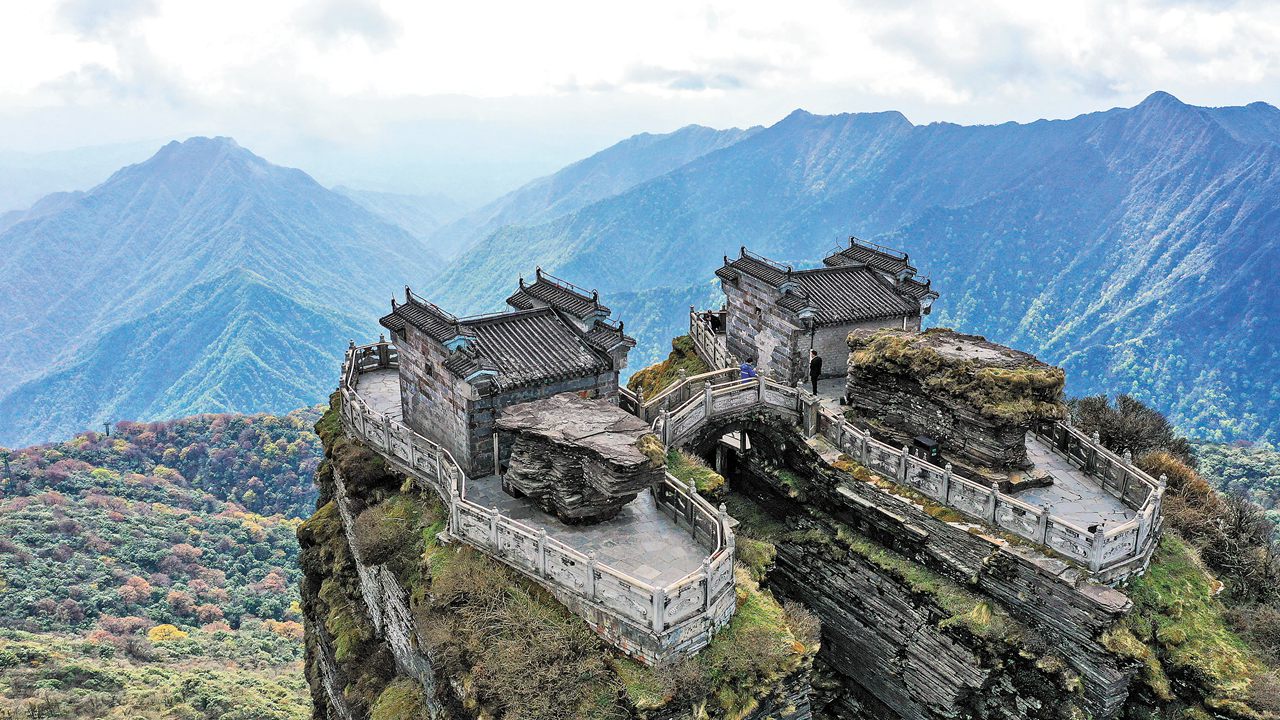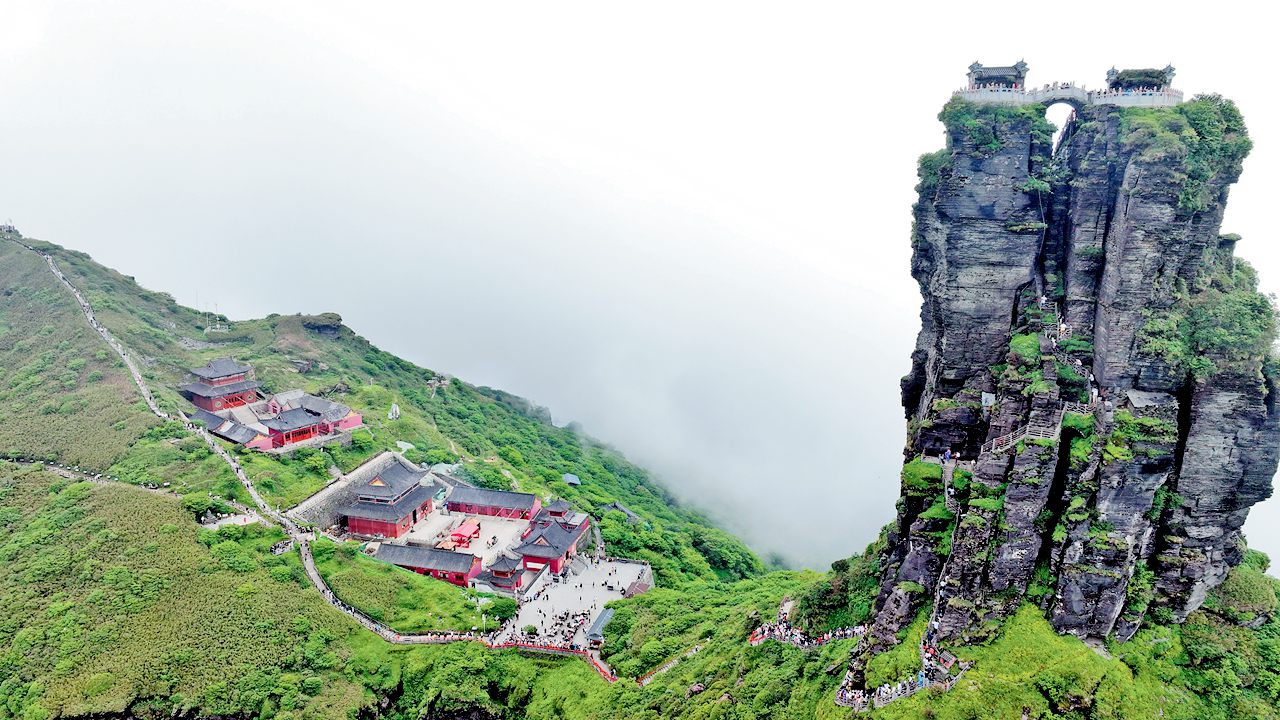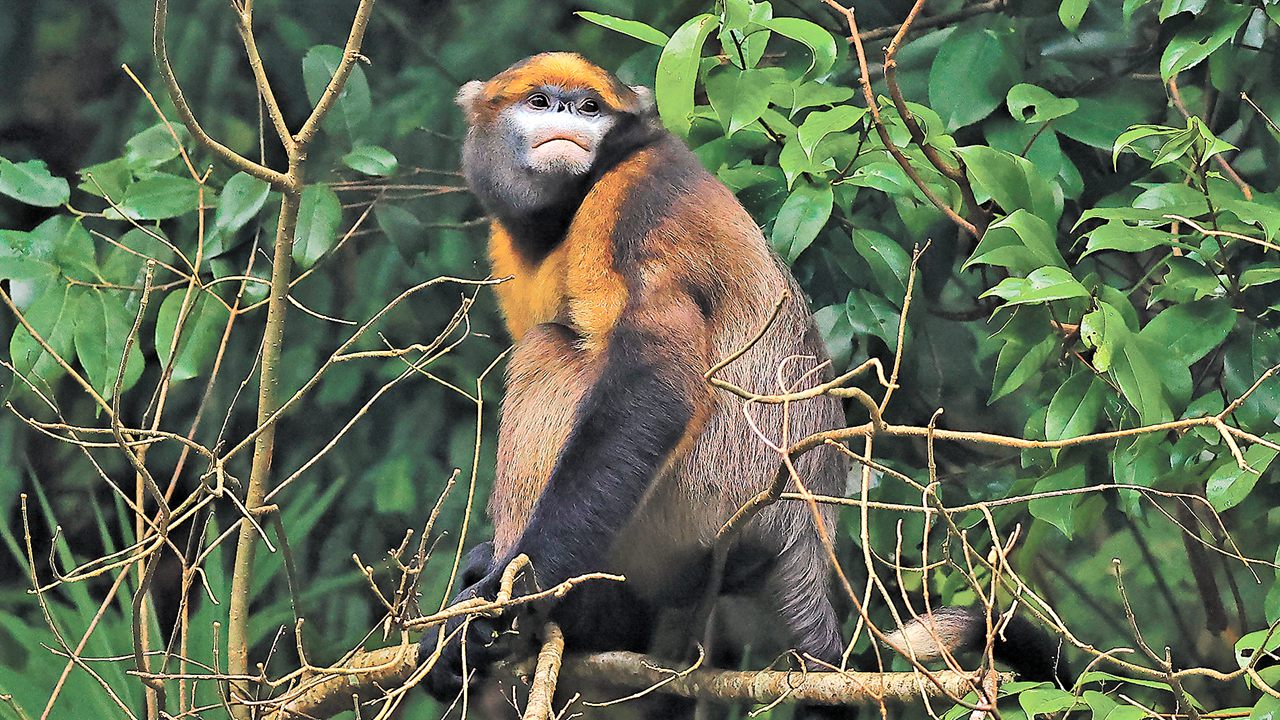Mount Fanjing, a land of purity
Writer: Debra Li | Editor: Zhang Zeling | From: Original | Updated: 2024-05-06

An aerial view of the temples on the New Golden Summit of Mount Fanjing. Photos by Xinhua
A search online for Mount Fanjing will lead to images of a majestic, otherworldly peak rising into the clouds, reminiscent of Laputa from Japanese filmmaker Hayao Miyazaki’s “Castle in the Sky.”

A general view of Mount Fanjing, a UNESCO World Heritage site in Guizhou Province.
Inscribed onto the World Heritage List by UNESCO in 2018, Mount Fanjing, located in Tongren City, is less commercialized and less crowded compared to other tourist destinations in Guizhou Province, such as Huangguoshu Waterfall and the stone arch bridges of Libo Ancient Town — which is a blessing in this era of overtourism. Not just a trove of natural treasures with breathtaking views, this land at the borders of Guizhou, Hunan, and Chongqing displays diverse cultural traditions of ethnic minorities as well.
Some 248 kilometers from the provincial capital Guiyang, Mount Fanjing is the highest peak of the Wuling Mountains, at an elevation of 2,572 meters. It’s a national nature reserve covering 567 square kilometers, an ideal destination for hiking and sightseeing as well as a holy site for Buddhism.
With peaks rising, streams crossing, and waterfalls overflowing, Mount Fanjing features many attractions, including Golden Summit, Yuejing Mountain, Sleeping Buddha, Mushroom Stone, Jiulong Pond, and Phoenix Mountain.

A gray snub-nosed golden hair monkey is seen amid forests in Mount Fanjing, Tongren, Guizhou Province in this file photo.
The nature reserve is home to over 7,100 plant and animal species, some of which originated in the Tertiary period, between 70 million and 2 million years ago. The mountain is also home to the gray snub-nosed monkey, or “Guizhou golden hair monkey.” It has a bluish-white face and pink skin around the lips, and can be recognized by a white patch between its shoulder blades.
The name “Fanjing” is an abbreviation of the Buddhist term “Fantian Jingtu,” which means “Brahma’s Pure Land.” Listed as one of China’s top 5 Buddhist mountains, Mount Fanjing came under the influence of Buddhism in the Tang Dynasty (618-907). Temples were built during the ensuing Song (960-1279) and Yuan (1271-1368) dynasties. The two temples sitting atop the New Golden Summit today are a significant pilgrimage site for Buddhist worshipers around the world.
Like the Avatar Hallelujah Mountain in Zhangjiajie National Forest Park in Hunan Province, Mount Fanjing is much taller than it is wide, a vertical pinnacle that resembles a pencil standing on a desk.
The mountain has no shortage of peculiar rocks and captivating views, especially from the 2,336-meter-tall New Golden Summit (also known as Red Clouds Golden Summit because it’s surrounded by red clouds at sunset and sunrise).
Entering through the west gate, one needs to hike four hours over 8,000 steps before they can reach the mountaintop temples. The journey is rewarding though, as they can feast their eyes on views of mountains shrouded in a sea of mist and clouds, steep cliffs, and echoing caverns. The Mushroom Stone, standing at 10 meters tall, speaks to the area’s prehistoric formation. There are many other strange rock formations and stone pillars to behold along the way.
Those who lack the strength to climb the challenging steps can ride a cable car uphill, accessed through the east gate of the nature reserve.
There are regular bus services to Mount Fanjing from Tongren Railway Station, which is in turn accessible from Guiyang via bullet trains.
The best time to visit is from March to November. If you are planning to capture some breathtaking photos, the best time to visit is in the early morning. Those lucky enough will be rewarded by the breathtaking sunrise and even the mysterious spectacle of Buddha’s light.
The mountain has had to limit visitor numbers, among other measures, to protect this UNESCO World Heritage site. The plan allows no more than 23,480 visitors a day, which makes it necessary to be there a little earlier if you are visiting during public holidays.
The entrance ticket to Mount Fanjing for an adult visitor is 100 yuan (US$13.8) per person. Those who want to scale the New Golden Summit need to make further reservations (free of charge) when they arrive at the Mushroom Stone and wait their turn.
It’s also recommended to carefully plan your visit for a fair-weather day; otherwise, many beautiful scenes along the way will be hardly visible, being enshrouded in clouds and mist. Those who are determined to hike the peak are also advised to bring a jacket and gloves to prevent from getting cold and protect their hands during difficult climbs.
Tongren holds a unique allure shaped by the rich tapestry of 29 ethnic minorities that call the city home. Places like Zhaiying Ancient Town, Zhaisha Village of the Dong ethnic group, the historic Liu’s mansion, and the Anhua Old Street, each display distinct features that resonate with a storied past.
The city also beckons visitors with culinary treasures like the zesty sour and spicy rice noodles and a signature rice liquor.